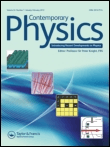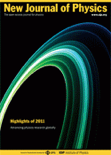
European Physical Journal-Special Topics
metrics 2024
Illuminating Topical Issues with Cutting-edge Research
Introduction
The European Physical Journal-Special Topics (EPJ ST), published by Springer Heidelberg, is an esteemed academic journal dedicated to the dissemination of high-quality research across various domains of physics and materials science. With an ISSN of 1951-6355 and E-ISSN 1951-6401, it serves as a platform for articles that delve into topical issues and emerging areas of interest. The journal consistently ranks in the upper quartiles of its categories, achieving Q2 in Materials Science, Q3 in Physical and Theoretical Chemistry, and Q2 in Physics and Astronomy for 2023. This underscores its significant impact in these fields, positioned well within percentile rankings that reflect its relevance and esteem among peers. With an impressive convergence from 2007 to 2024, EPJ ST not only contributes to theoretical advancements but also promotes collaborative research through its open-access options. Ultimately, it serves as an essential resource for researchers, professionals, and students pursuing innovative insights and advancements in physics and materials science.
Metrics 2024
 0.46
0.46 2.60
2.60 2.50
2.50 91
91Metrics History
Rank 2024
Scopus
IF (Web Of Science)
JCI (Web Of Science)
Quartile History
Similar Journals

BRAZILIAN JOURNAL OF PHYSICS
Exploring Innovations in the World of PhysicsBRAZILIAN JOURNAL OF PHYSICS, published by SPRINGER, is a prominent platform dedicated to the dissemination of research within the realm of physics and astronomy. With an ISSN of 0103-9733 and E-ISSN of 1678-4448, this esteemed journal has been contributing to the field since its inception in 1996, and it continues to be pivotal in showcasing innovative studies and breakthroughs. The journal is categorized in the Q4 quartile for the year 2023, reflecting a dedicated focus on advancing knowledge across a variety of disciplines, particularly in general physics and astronomy, where it ranks 126th out of 243 in Scopus rankings. Although it currently does not operate under an open-access model, it remains an invaluable resource for researchers, professionals, and students eager to enhance their understanding of complex physical principles and developments. The journal is committed to promoting high-quality research, bridging gaps in knowledge, and fostering collaboration within the global physics community.

ACTA PHYSICA POLONICA B
Advancing Physics through Rigorous InquiryACTA PHYSICA POLONICA B is a distinguished journal published by Jagiellonian University Press, based in Poland. This peer-reviewed publication focuses on advancing the field of Physics and Astronomy with a mission to disseminate high-quality research that spans various subfields and interdisciplinary connections. Since its inception in 1980, the journal has steadily become a reliable source of scientific discourse, continuing its commitment through 2024. With a Q3 rank in the Physics and Astronomy category, it stands as an important resource for both established and budding researchers, contributing to a deeper understanding of complex physical phenomena. The journal is indexed by Scopus, ensuring a broad reach within the academic community, although it is not classified as an open-access resource. By promoting rigorous scientific inquiry and fostering connections within the global academic landscape, ACTA PHYSICA POLONICA B plays a vital role in shaping the future of physics research.

Nature Reviews Physics
Unveiling the Latest Breakthroughs in Physics.Nature Reviews Physics is a leading academic journal published by NATURE PORTFOLIO, specializing in the realm of physics and astronomy. With a significant impact factor that places it among the top-tier journals in its field, it has achieved a remarkable ranking of 3rd out of 243 according to Scopus, reflecting its influential position and 98th percentile standing in general physics and astronomy. This prestigious journal, with an expected convergence spanning from 2019 to 2024, provides comprehensive reviews that capture the latest advancements and critical developments in physics, deemed essential for researchers, professionals, and students alike. While the journal does not currently adopt an open-access model, its scholarly contributions and insights into cutting-edge research make it a vital resource for those seeking to advance their understanding of the complexities of the physical universe.

JOURNAL OF STATISTICAL PHYSICS
Connecting researchers to the pulse of Statistical Physics.The Journal of Statistical Physics, published by Springer, is a premier academic journal that has made significant contributions to the fields of Mathematical Physics and Statistical and Nonlinear Physics since its inception in 1969. With a strong reputation reflected in its 2023 rankings—placing it in Q2 of both categories and achieving an impressive Scopus rank of #22 in Mathematical Physics and #25 in Statistical and Nonlinear Physics—this journal serves as a vital platform for researchers, professionals, and students. The impact factor of the journal underscores its importance in disseminating cutting-edge research and theoretical developments. Authors are invited to submit original research articles that explore the intricate complexities of statistical mechanics, quantum physics, and related disciplines, fostering deep insights and academic discourse. Although the journal does not currently offer open access, its robust editorial standards and commitment to advancing knowledge make it an essential resource for those engaged in these dynamic fields.

CONTEMPORARY PHYSICS
Exploring the Frontiers of Physics and AstronomyCONTEMPORARY PHYSICS, published by Taylor & Francis Ltd, stands as a notable journal in the field of physics and astronomy, offering a comprehensive platform for the dissemination of cutting-edge research and developments since its inception in 1959. With an Impact Factor that reflects its solid position within the academic community, as evidenced by its Q2 ranking in the 2023 category of Physics and Astronomy (miscellaneous) and a Scopus Rank of 111 out of 243, this journal plays an essential role in bridging theoretical advances and practical applications. Researchers and professionals are encouraged to explore its diverse scope, which aims to foster innovative ideas and foster interdisciplinary collaboration. Although not currently an open access journal, CONTEMPORARY PHYSICS is committed to maintaining the highest standards of editorial excellence and provides valuable insights across converged eras of research from 1959 to 2024, making it indispensable for those dedicated to advancing their knowledge and contributions in the realm of physics.

Revista Cubana de Fisica
Pioneering Open Access in the Realm of Physics ResearchRevista Cubana de Fisica is a prominent open-access journal based in Cuba, published by EDICIONES CUBANAS. With its ISSN 0253-9268 and E-ISSN 2224-7939, this journal has been dedicated to advancing the field of Physics and Astronomy since its transition to open access in 2005, making high-quality research readily available to a global audience. Despite its current Scopus rank of #229 out of 243 in the genre, placing it in the 5th percentile, the journal remains a vital platform for disseminating innovative studies and findings, particularly within the broader scientific community in Latin America. Covering a diverse range of topics in physics, the magazine aspires to foster collaboration among researchers, students, and professionals alike, thus bridging the gap between theoretical exploration and practical application. The journal operates under the ambitious objective of contributing to the advancement of scientific knowledge from 2011 to 2024 and beyond, reinforcing its commitment to addressing contemporary challenges in physics and fostering a vibrant academic culture.

REVISTA MEXICANA DE FISICA
Pioneering Insights in Physics and Educational MethodologiesREVISTA MEXICANA DE FISICA is a prominent academic journal dedicated to advancing knowledge in the fields of Physics and Education. Published by the SOC MEXICANA FISICA, this journal plays a pivotal role in disseminating innovative research and educational methodologies from Mexico and beyond. With a publication history that spans from 1991 to 2024, it has established itself as an essential resource for researchers, professionals, and students who seek to deepen their understanding of general physics and astronomy. The journal is classified in the Q3 quartile in both education and physics & astronomy, showcasing its quality and relevance within the academic landscape. While the journal currently operates on a subscription basis, it provides a valuable platform for emerging voices and established scholars alike. By fostering a collaborative environment for scientific discourse, REVISTA MEXICANA DE FISICA continues to be an important channel for the ongoing evolution of scientific education and exploration in the physical sciences.

Nuovo Cimento C-Colloquia and Communications in Physics
Illuminating New Frontiers in PhysicsNuovo Cimento C-Colloquia and Communications in Physics is a distinguished peer-reviewed journal published by the SOC ITALIANA FISICA, dedicated to the dissemination of novel research and communications in the vibrant fields of Astronomy and Physics. Established in 1978, this journal provides a platform for scientists and researchers to present their findings, fostering academic dialogue and collaboration within the community. As of 2023, the journal holds a Q4 quartile ranking in both Astronomy and Astrophysics and Physics and Astronomy (miscellaneous), reflecting its commitment to contributing to the scientific corpus despite its emerging status in the competitive landscape. Based in Italy, the journal is accessible to a global audience, enhancing its reach and influence. Although currently not an open access journal, it remains an essential resource for researchers and professionals seeking to stay informed on cutting-edge developments in physics and astronomy. Its ongoing convergence of knowledge from 1978 to 2024 promises to enrich the scholarly discourse and advance the frontiers of research in these dynamic fields.

Frontiers of Physics
Advancing the Boundaries of Physics ResearchFrontiers of Physics, published by Higher Education Press, is a premier open-access journal dedicated to fostering innovative research and excellence within the field of physics. With an ISSN of 2095-0462 and an E-ISSN of 2095-0470, this rapidly growing journal has established itself as a valuable platform for disseminating cutting-edge findings, covering a diverse range of topics from theoretical frameworks to experimental advancements. Notably, Frontiers of Physics has achieved an impressive Q1 ranking in the 2023 Scopus Quartiles for Physics and Astronomy, securing a competitive 5th out of 81 positions in its category, reflecting a high impact factor that underscores its importance to the scientific community. Since its inception in 2011 and continuing through 2024, the journal aims to bridge the gap between academia and industry, encouraging collaboration among researchers, professionals, and students alike. Its commitment to open access ensures that high-quality research is readily accessible, thereby promoting knowledge sharing and advancement in the global physics community. Explore the potential of your research in Frontiers of Physics, where the future of physics flourishes.

NEW JOURNAL OF PHYSICS
Bridging theory and practice in contemporary physics.NEW JOURNAL OF PHYSICS, published by IOP Publishing Ltd, is a prestigious open-access journal that has been at the forefront of the physics community since its inception in 1998. With an impact factor that places it in the Q1 category of Physics and Astronomy (miscellaneous) and a commendable ranking of #49 out of 243 in the general physics and astronomy category according to Scopus, this journal is recognized for its significant contribution to advancing research in the field. The journal caters to a broad scope of topics, providing a platform for the dissemination of cutting-edge research findings and innovative theoretical explorations. Operating from the United Kingdom, it offers a truly international perspective, making its contents accessible and impactful to a global audience. With robust open-access options, the NEW JOURNAL OF PHYSICS ensures that research findings are freely available, promoting collaboration and knowledge sharing among researchers, professionals, and students alike. This commitment to accessibility, combined with its high-quality content, makes it an essential resource for anyone engaged in the physics community.